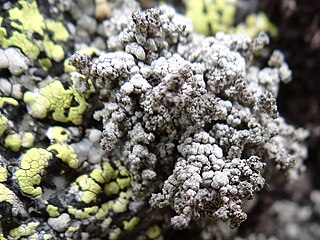
Rhizocarpon geographicum is a species of lichen, which grows on rocks in mountainous areas of low air pollution. Each lichen is a flat patch bordered by a black line of fungal hyphae. These patches grow adjacent to each other, leading to the appearance of a map or a patchwork field.
Geltingia is a fungal genus in the family Helicogoniaceae. It is monotypic, containing the single lichenicolous species Geltingia associata. The genus was circumscribed in 1990 by mycologists Vagn Alstrup and David Leslie Hawksworth. The genus name honours Danish scientist Paul Gelting.

Candelariella vitellina is a common and widespread green-yellow to orange-yellow crustose areolate lichen that grows on rock, wood, and bark, all over the world. It grows on non-calcareous rock, wood, and bark.
Roy Watling, PhD., DSc, FRSE, F.I.Biol., C.Biol., FLS is a Scottish mycologist who has made significant contributions to the study of fungi both in the identification of new species and correct taxonomic placement, as well as in fungal ecology.
Ascobolus immersus is a species of fungus belonging to the family Ascobolaceae.

Stereocaulon alpinum is a species of fungus belonging to the family Stereocaulaceae. It is similar to Stereocaulon paschale but differs from it in containing cyanobacteria of the genus Nostoc while S. paschale contains cyanobacteria of the genus Stigonema, which have a darker colour than Nostoc.
Carbonea supersparsa is a species of lichenicolous fungus belonging to the family Lecanoraceae. It is widespread in the Northern Hemisphere. In Iceland it has been reported growing on Lecanora cenisia near Egilsstaðir and Lecanora polytropa near Seyðisfjörður.

Carbonea vitellaria is a species of lichenicolous fungus belonging to the family Lecanoraceae. It has a worldwide distribution. In Iceland it has been reported growing on Candelariella vitellina near Egilsstaðir and on King George Island, Antarctica.

Muellerella lichenicola is a species of lichenicolous fungus in the family Verrucariaceae. It was first formally described as a new species in 1826 by Søren Christian Sommerfelt, as Sphaeria lichenicola. David Leslie Hawksworth transferred it to the genus Muellerella in 1979.

Muellerella ventosicola is a species of lichenicolous fungus in the family Verrucariaceae. It shows preference to growing on species of the genus Rhizocarpon but can also associate with other genera.
Lichenopeltella cetrariae is a species of fungus belonging to the class Dothideomycetes. It has been found growing on Cetraria aculeata in Hrútey near Blönduós, Iceland and on Cetraria laevigata in Bulgan district, Mongolia and Toyama prefecture, Japan. In Japan, it has also been reported growing on Flavocetraria cucullata in Yamanashi prefecture and Nagano prefecture.
Lichenopeltella cetrariicola is a species of lichenicolous fungus belonging to the class Dothideomycetes. It has been reported from Europe and Iceland but it probably has a more widespread distribution. It has been reported from at least two host species, Cetraria islandica and Cetraria aculeata.

Muellerella pygmaea is a species of lichenicolous fungus in the family Verrucariaceae. It has a cosmopolitan distribution in Arctic-alpine areas and grows on the thallus and apothecia of a number of hosts.
Schizothecium tetrasporum is a species of coprophilous fungus in the family Lasiosphaeriaceae. It is known to grow in the dung of goats and rabbits.
Schizothecium vesticola is a species of coprophilous fungus in the family Lasiosphaeriaceae. In Greece, it is known to grow in the dung of goats and possibly on that of sheep, goats and donkeys. In Iceland, it has been reported from the dung of sheep, goose and horse.

Stereocaulon vesuvianum is a species of snow lichen belonging to the family Stereocaulaceae.
Cercidospora stereocaulorum is a species of lichenicolous fungus in the genus Cercidospora but it has not been assigned to a family. It is known to parasitise lichens of the genus Stereocaulon.
Bryostigma epiphyscium is a species of lichenicolous fungus in the order Arthoniales. Formerly classified in the genera Arthonia and Conida, it was transferred to the genus Bryostigma in 2020.
Arthonia stereocaulina is a species of lichenicolous fungus in the family Arthoniaceae.
Scutula stereocaulorum is a species of lichenicolous fungus in the family Ramalinaceae.







